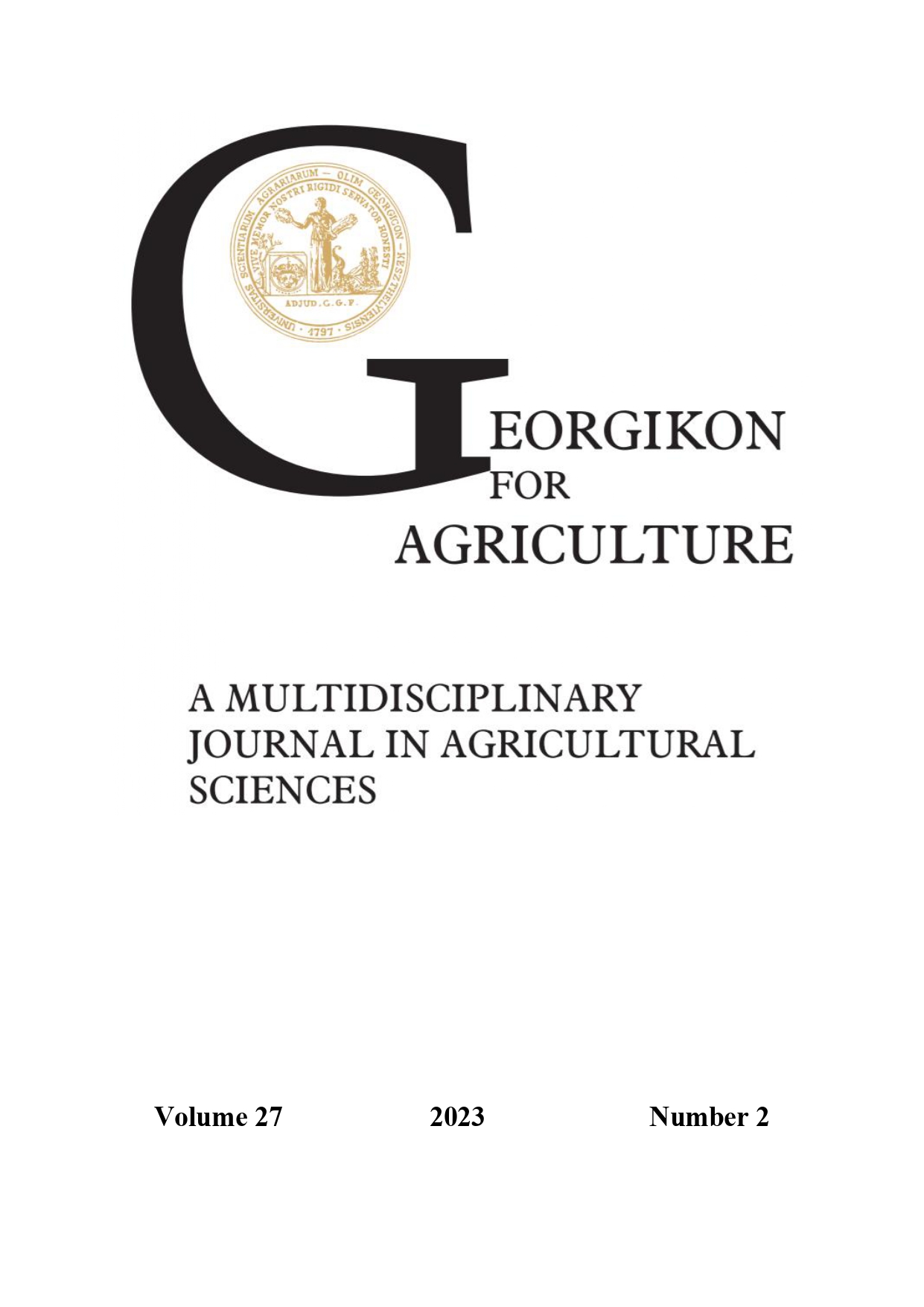A bomlási együtthatók alakulása különböző avarfélék esetében
Kulcsszavak:
fűz, nyár, nád, avarkeverék, bomlási együtthatóAbsztrakt
A vízben történő avarlebontási folyamatok egyik fő abiotikus mozgatórugója a hőmérséklet. A nemzetközi szakirodalomban a hagyományos exponenciális bomlási együttható (k, nap-1) értékével tehetjük összehasonlíthatóvá a különböző környezeti feltételek közt mért értékeket. Ezen mutató azonban nem veszi figyelembe a hőmérsékletet, csupán a visszamaradt tömeggel és az eltelt idővel számol. A vízhőmérséklet figyelembevételére a vízhőmérséklettel kompenzált bomlási együttható alkalmas (ktemp, nap-1). A kutatás során egy mikrokozmosz kísérletben (hagyományos A kádban) 3 avar-típus (fűz avar, Salix sp.; nyár avar, Populus sp.; nád, Phragmites australis), valamint ezek keverékét vizsgáltuk avarzsákos módszerrel 2022. június 10 és szeptember 2. között. Eredményeink alapján elmondható, hogy ktemp értékei magasabbak a k értékeknél, valamint az avarféleségek és keverékeik közti különbségek is a ktemp esetében jobban láthatóvá váltak. A nádat leszámítva az avarkeverékek magasabb eltérést mutattak, mint az egyféle avart tartalmazó avarmintáknál k és ktemp értékeit összehasonlítva.
Hivatkozások
Abelho, M. 2001. From litterfall to breakdown in streams: a review. The Scientific World Journal. 1 656–680. https://doi.org/10.1100/tsw.2001.103
Anda, A., Simon, Sz., Simon-Gáspár, B. 2023. Impacts of wintertime meteorological variables on decomposition of Phragmites australis and Solidago canadensis in the Balaton System. Theoretical and Applied Climatology. 151 1963–1979. https://doi.org/10.1007/s00704-023-04370-y
Asaeda, T., Nam, L.H. 2002. Effects of rhizome age on the decomposition rate of Phragmites australis rhizomes. Hydrobiologia. 485 205–208. https://doi.org/10.1023/A:1021314203532
Bärlocher, F. 2005. Leaf Mass Loss Estimated by Litter Bag Technique. In: Graça M.A.S., Bärlocher F., Gessner M.O., Eds., Methods to Study Litter Decomposition, a Practical Guide, Springer, Dordrecht, pp. 37–42. https://doi.org/10.1007/1-4020-3466-0_6
Bärlocher, F; Gessner, M.O.; Graca, M. A. S. 2020. Leaf mass loss estimated by the litter bag technique. Methods to study litter decomposition. A Practical Guide (2nd ed.) SpringerNature Switzerland AG., Part 1., pp. 43–51. https://doi.org/10.1007/978-3-030-30515-4_6
Boyero, L.; Pearson, R. G.; Gessner, M. O.; Barmuta, L. A. 2011. A global experiment suggests climate warming will not accelerate litter decomposition in streams but might reduce carbon sequestration. Ecology Letters. 14 (3) 289–94. https://doi.org/10.1111/j.1461-0248.2010.01578.x
Brown, J. H.; Gillooly, J. F.; Allen, A. P. 2004. Toward a metabolic theory of ecology. Ecology. 85 (7) 1771–1789. https://doi.org/10.1890/03-9000
Chen, Y., Ma, S., Jiang, H., Yangzom, D., Cheng, G., Lu, X. 2019. Decomposition time, chemical traits and climatic factors determine litter-mixing effects of decomposition in an alpine steppe ecosystem in Northern Tibet. Plant Soil. 459 23–35. https://doi.org/10.1007/s11104-019-04131-9
Chergui, H.; Pattee, E. 1990. The influence of season on the breakdown of submerged leaves. Arch. Hydrobiol. 120 (1) 1–12. https://doi.org/10.1127/archiv-hydrobiol/120/1990/1
Dobson, M.; Frid, C. 1998. Ecology of Aquatic Systems. Longman, Essex
Ferreira, V.; Chauvet E. 2011. Synergistic effects of water temperature and dissolved nutrients on litter decomposition and associated fungi. Global Change Biol. 17 (1) 551–564. https://doi.org/10.1111/j.1365-2486.2010.02185.x
Mátyás, Cs. 1997. Erdészeti ökológia. Mezőgazda Kiadó, Budapest.
Meentemeyer, V. 1978. Macroclimate and lignin control of litter decomposition rates. Ecology. 59 (3) 465–472. https://doi.org/10.2307/1936576
Nakajima, T.; Asaeda, T.; Fujino, T.; Nanda, A. 2006. Leaf Litter Decomposition in Aquatic and Terrestrial Realms of a Second-Order Forested Stream System. Journal of Freshwater Ecology. 21 (2) 259–263. http://dx.doi.org/10.1080/02705060.2006.9664994
Petersen, R. C.; Cummins, K. W. 1974. Leaf processing in a woodland stream. Freshwater Biology. 4 (4) 343–368. https://doi.org/10.1111/j.1365-2427.1974.tb00103.x
Sokolova, I. M.; Lannig, G. 2008. Interactive effects of metal pollution and temperature on metabolism in aquatic ectotherms: implications of global climate change. Climate Research. 37 181–201. http://dx.doi.org/10.3354/cr00764
Wallace, J. B.; Whiles, M. R.; Eggert, S.; Cuffney, T. F.; Lugthart, G. J.; Chung, K. 1995. Long-term dynamics of coarse particulate organic matter in three Appalachian Mountain Streams. Journal of the North American Benthological Society. 14 (2) 217–232. http://dx.doi.org/10.2307/1467775
Webster, J. R.; Benfield, E. F. 1986. Vascular plant breakdown in freshwater systems. Annual Review of Ecology and Systematics. 17 567–594. http://dx.doi.org/10.1146/annurev.es.17.110186.003031
Letöltések
Megjelent
Folyóirat szám
Rovat
License
Copyright (c) 2023 Simon-Gáspár Brigitta, Tóth Ariel, Simon Szabina, Soós Gábor, Anda Angéla

This work is licensed under a Creative Commons Attribution-NonCommercial-NoDerivatives 4.0 International License.
The articel is under the Creative Commons 4.0 standard licenc: CC-BY-NC-ND-4.0. Under the following terms: You must give appropriate credit, provide a link to the license, and indicate if changes were made. You may do so in any reasonable manner, but not in any way that suggests the licensor endorses you or your use. You may not use the material for commercial purposes. If you remix, transform, or build upon the material, you may not distribute the modified material. You may not apply legal terms or technological measures that legally restrict others from doing anything the license permits.




 Georgikon for Agriculture
Georgikon for Agriculture